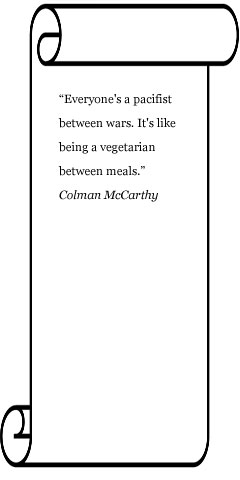|
Left Up in the Air
The Air Services of the Low Countries in WWII
By David Meyler
November 2012
The forces of the smaller nations involved in the vast conflict
of the Second World War are often given just a cursory glance,
when not overlooked completely. Third
Reich and Great
Pacific War are big games and vast in scope, and
small air forces like those of the Netherlands and Belgium
rate just one TAC factor each (plus another Dutch TAC counting
the air force in the East Indies). In the game they tend to
come and go pretty quickly.
However, while the Dutch and Belgian forces are often lumped
together in the �Low Countries,� they were quite
distinctive in the short time they survived in combat. This
look provides some background on what those single TAC factors
represent.

Belgium�s armored might, 1939.
While the Belgian military establishment in 1940 is generally
seen as larger and more effective than the Dutch (especially
as the Dutch population was somewhat larger), this is misleading.
While the army was smaller (the Dutch army totalled 47 infantry
and 9 cavalry or cyclist regiments, to the Belgian army�s
54 infantry regiments and 22 motorized, cyclist and cavalry
regiments), the Dutch supported a fairly large navy with a
naval air service. Belgium�s naval forces were negligible.
The Netherlands also had a significant air industry with two
major manufacturers, Fokker and Koolhoven, producing military
aircraft both for home use and export.
The Belgian air force (Belgische Luchtmacht or Force Arienne
Belge) while numerically larger (roughly 180 operational aircraft
to 150), was actually much weaker than the Dutch air service.
The Netherlands� Luchtvaartafdeling could put almost
60 modern monoplane fighters into the air. The Belgians generally
remained dependant on the biplane and had but one squadron
of 11 monoplane fighters.
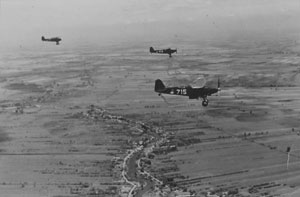
The Dutch used biplanes, too.
C.10 light bombers on a strike mission, 13 May 1940.
Belgian soldiers took great pride in their army's performance during the First
World War. At the same time, Belgian officers tended to look
down on the Dutch military as amateurs who had not been blooded
during the Great War. The Belgian high command did not trust
the ability or the will of their northern neighbours to resist
a German invasion. This proved to be a major stumbling block
in developing a joint defensive strategy with the Dutch, and
just like the ground forces, the air forces of each nation
would fight their own separate battles.
Ironically, however, the Dutch had been the first nation in
Western Europe to mobilize their armed forces in the summer
of 1914. Thanks to an effective intelligence service, the
Dutch had early warning of the German mobilization, although
they mistakenly believed this would result in an immediate
invasion of their territory.
The impact of the First World War had more insidious effects.
While many Dutch, in spite of all the warning indications,
still believed the Germans would not invade, the Belgian army
fully expected and feared a German attack. During the winter
of 1939-40, the Belgians waited for an attack that did not
come. The many false alerts, the boring hours of uneventful
patrols and the continuous uncertainty, sapped morale and
alertness. When the real attack did come on 10 May 1940, the
Belgian reaction was mixed and uncertain. The Germans, in
turn, would be surprised by the ferocity of the supposedly
docile Dutch. One advantage of small size is that Belgian
and Dutch aircrews tended to be of high quality. Turnover
was low, and as it was difficult to get into the air services,
they developed into something of an elite.

Dutch G1 fighters.
One enduring myth from the campaign is the destruction of
the Dutch air force on the ground by the Luftwaffe at dawn
on 10 May 1940. Only at Bergen airfield, on the North Sea
coast west and north of Amsterdam, were the Dutch caught on
the ground losing a dozen of the new Fokker G1 fighters. This
loss was bad enough, but at every other airfield, the Germans
met a determined defence. The G1 squadron at Waalhaven got
eight of its 11 aircraft into the air. The ensuing air battle
proved to be one of the most lopsided of the whole battle
of France. The Luftwaffe lost 13 aircraft shot down (eight
bombers, three Messerschmitt fighters and two Ju52s). Just
one G1 was lost (the tail gunner of this aircraft was killed
by bomb splinters while running to his plane).
Noteworthy was the action of Lieutenant Bram (Bob) van der
Stok, based at De Kooy, during another of the largest dogfights
of the first day. Eight Fokker D21s from De Kooy faced nine
Messerschmitt Bf109Es from II(J)/TrGr186 (part of the air
unit slated to serve on the never completed German aircraft
carrier Graf Zeppelin). 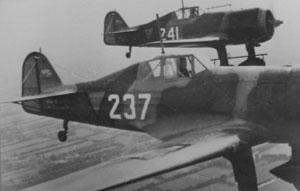
Dutch D.21 fighters over the Grebbeberg.
It was another surprise defeat for the ostensibly superior
Germans. Although slower, the Dutch used the better manoeuvrability
of the D.21 to advantage. Five 109s were shot down, including
the squadron leader�s machine, with another two damaged.
The Dutch lost no aircraft. After May 1940, van der Stok escaped
to Britain and flew Spitfires with the RAF until he was shot
down and made a POW. He participated in the Great Escape from
Stalag Luft III in March 1944, and became one of only three
POWs to successfully get away. He eventually came to command
No. 322 Squadron. In the film The Great Escape, his
character was turned into an Aussie.
Over the next five days, the Dutch air force fought a grim
battle of attrition, heavily outnumbered and with only negligible
aid from the French and British. Most action took place on
10 May, the first day with more than 100 sorties. The Dutch
alone faced the full onslaught of the whole of Luftflotte
2�s 600 combat aircraft (not counting the air transport
fleet of 500 Ju52s). Managing only about 30 sorties on May
11, it looked as if the Dutch air force had collapsed, yet
the next day close to 100 sorties were mounted again.
The two single largest concentrations of Dutch aircraft,
less than a dozen aircraft each, were seen on 12 May during
the battle for the Grebbeberg, but this day proved to be the
last gasp. Still, on the morning of 14 May, just before the
capitulation of the Dutch army, the air force was mounting
defensive patrols, singly or in groups of two, three or four,
with whatever could be scraped together, patched up and sent
into the air: seven D.21s, four G.1s and a C.5.
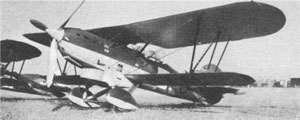
Belgian Fairey Fox bombers, 1937.
The Belgian air force was effectively suppressed on 10 May,
suffering heavy losses on the ground. At Schaffen all but
one of the 11 Hawker Hurricane fighters were wiped out, while
the squadron of 15 Gladiators lost about six aircraft. Of
the 23 Fiat biplanes, about 14 were destroyed. In total, about
80 aircraft were lost on the ground. The 14 Battle bombers,
the only modern bomber force the Belgians had, were massacred
on 11 May attempting to knock out the Maas bridges at Maastricht.
The Belgian air force had only a negligible impact thereafter.
By the time of the Belgian surrender on 28 May, just a handful
of reconnaissance planes remained operational, covering the
last battles along the Lys River. Both British and French
air activity was fairly heavy over Belgium, supporting the
large forces they had put into the country.
The KNIL Luchvaartdienst (Netherlands East Indies Army Air
Service) by December 1941 was stronger than the home air force
had been at the outbreak of the war, with about 200 aircraft,
mostly monoplanes. The LVD saw widespread service from Singapore
in December to the fall of Java in early March 1942, but was
never a match for the Japanese in terms of numbers and quality.
A single flight of four Buffalo fighters was all that remained
to cover the last battle at Lembang, 6-7 March.
Belgian Air Force
(Belgische Luchtvaart, Force Arienne Belge)
Equipment
Fairey Fox: The Belgian air force
had remained true to the biplane as its primary type of aircraft.
Most numerous was the Fox, a British design produced almost
exclusively in Belgium. A solid, conventional early 1930s
design, the two-seat Fox served as bomber, fighter and reconnaissance.
The final model VIII appeared in 1938, offering few improvements
on what had by then become a thoroughly obsolete design. Performance
ranged from 302 km/hour as top speed for the Fox II to 380
km/hour for the Fox VIII. Typical armament was twin front-firing
machine guns (except the Fox II with just one gun) with a
flexible mounted machine gun in the rear cockpit. Bomb load
was 200 kg. A total of 40 II models were built including two
trainers and 12 reconnaissance versions, with 55 type IIIs
(six reconnaissance), 76 type VIs (24 reconnaissance) and
15 type VIIIs (all fighters). The single type VII fighter
was actually a single-seat conversion of a type VI, built
for Willy Coppens, Belgium's highest-scoring ace from the
First World War.
Fiat CR.42: Italian manufactured
biplane, 34 delivered to Belgium � 430 km/hour, two
forward-firing machine guns.
Gloster Gladiator: Another biplane,
main British fighter up to 1938/39, 22 delivered to Belgium
� 414 km/h,our four machine guns.

A flight of Battles.
Fairey Battle: Essentially a low-wing
monoplane fighter with an extended fuselage to allow for extra
crew members. But instead of a fast and nimble craft, the
Battle proved to be underpowered, slow and vulnerable with
an inadequate bomb load. Belgium operated one squadron, with
incredibly brave crews, which was all but wiped out on May
11 in a raid against the German-held bridges at Veldwezelt
and Vroenhoven. Top speed of 388 km/hour, one forward-firing
machine gun and one in the rear cockpit, 454 kg bomb load.
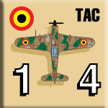 Hawker
Hurricane I: Belgium had just one squadron,
and it was virtually wiped out in a single air raid on the
first day of the war. This serves as the icon for the Belgian
TAC unit in the game. Hawker
Hurricane I: Belgium had just one squadron,
and it was virtually wiped out in a single air raid on the
first day of the war. This serves as the icon for the Belgian
TAC unit in the game.
Renard R31: One of the few Belgian-designed
aircraft, used for reconnaissance.
Order of Battle, May 1940
1st Regiment (Army cooperation)
Deurne: 1/I/1 Sqd (10 Fairey Fox
II and III)
Gossoncourt: 3/II/1 Sqd (12 Fairey
Fox II, III and IIIc), 5/III/1 Sqd (ten Fairey Fox IV), 7/IV/1
Sqd (nine Fairey Fox VI) (the "c" suffix stands
for "combat" and indicates a fighter or bomber variant,
others are reconnaissance types)
Bierset: 9/V/1 Sqd (11 Renard
R-31), 11/VI/1 Sqd (ten Renard R-31)
2nd Regiment (Air Defence)
Schaffen: 1/I/2 Sqd (15 Gloster
Gladiator MkI), 2/I/2 Sqd (11 Hawker Hurricane MkI), 5/III/2
Sqd (15 Fairey Fox VIc fighter)
Nivelles: 3/II/2 Sqd (15 Fiat
CR.42), 4/II/2 Sqd (eight Fiat CR.42)
Le Zoute: 6/III/2 Sqd (14 Fairey
Fox VIc and oneVIIc fighter)
3rd Regiment (Long Range Reconnaissance/Bombing)
Ev�re: 1/I/3 Sqd (nine
Fairey Fox III and IIIc), 3/I/3 Sqd (nine Fairey Fox III),
5/III/3 Sqd (14 Fairey Battle), 7/III/3 Sqd (nine Fairey Fox
VIII)
Dutch Air Force
(Luchtvaartafdeling)
Equipment
Fokker S9: Trainer.
Fokker C5: When introduced in
1925, this sleek biplane was a decade ahead of its time. �W�
was the floatplane version. The fighter version was designated
D5, but even the bomber version was faster than most contemporary
interceptors. Although still in service with several air forces,
by 1940 the plane was long obsolete, and in Dutch usage served
as the primary reconnaissance aircraft � 225 km/hour,
one or two forward-firing machine guns and one machine gun
in a flexible mounting in the rear cockpit.
Fokker C7W: The floatplane version
of the C5 proved unsatisfactory, and the C7W was designed
as a replacement.
Fokker C8 maritime reconnaissance: 232
km/hour, three crewmen, twin rear-firing machine guns, and
one machine gun mounted through the bottom floor.
Fokker C10 reconnaissance/bomber: Two-seater
biplane, top speed of 355 km/hour, twin forward-firing machine
guns, with a another pair of swivel-mounted guns in the rear
cockpit. The C11 and C14 reconnaissance floatplanes were similar
to the C10.
Fokker D17 fighter: Obsolete biplane,
relegated to the flight schools, six machines were brought
back into front-line service as emergency escort fighters.
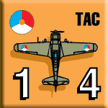 Fokker
D21: Low-wing monoplane fighter, 460 km/hour,
four machine guns � the icon for the Dutch TAC units
in the game. Fokker
D21: Low-wing monoplane fighter, 460 km/hour,
four machine guns � the icon for the Dutch TAC units
in the game.
Fokker G1a: Twin-engined boxtail
heavy fighter, capable of dogfighting with the Bf109 �
475 km/hour, crew of two or three, with one swivel mounted
machine gun in the rear, and eight forward-firing machine
guns or two 20mm cannon and four machine guns. The lighter
G1b export variant had a crew of two.
Fokker T5: Twin-engined medium
bomber and gun-ship, armed with a 20mm Solothurn cannon and
four 7.9mm machine guns in rear and ventral mounts, bomb load
of 1000kg, speed of 418 km/hour.
Fokker FVII: Civilian transport
aircraft modified for military duty.
Koolhoven FK51: Twin-seat biplane,
standard artillery spotter.
Douglas A8-3N: One of the few
foreign-produced aircraft in Dutch service, it was designed
as a ground-attack bomber, the Dutch used it as a two-seater
fighter � against the German Messerschmidts it proved
hopelessly inadequate.
Order of Battle, May 1940
1st LVA Regiment, Air Defence (HQ Schiphol)
Reconnaissance Squadron (Bergen): 10
Fokker C10
Bomber Squadron (Schiphol): Nine
Fokker T5, plus an independent flight of three Fokker F7 night
bombers
1st Fighter Squadron (De Kooy):
11 Fokker D21
2nd Fighter Squadron (Schiphol):
Nine Fokker D21
3rd Fighter Squadron (Waalhaven):
11 Fokker G1a
4th Fighter Squadron (Bergen): 12
Fokker G1a
2nd LVA Regiment, Army Support (HQ Zeist)
1st Reconnaissance Group (Hilversum): One
Fokker C10, four Fokker C5D, four Koolhoven FK51
2nd Reconnaissance Group (Ypenburg): Seven
Fokker C5D, five Koolhoven FK51
3rd Reconnaissance Group (Ruigenhoek): Nine
Fokker C5D, four Koolhoven FK51
4th Reconnaissance Group (Gilze-Rijen):
Seven Fokker C5D, three Koolhoven FK51
1st Fighter Squadron (Ypenburg):
Nine Fokker D21
2nd Fighter Squadron (Ypenburg): Non-operational,
to be equipped with 15 Fokker G1 by June, 1940
3rd Fighter Squadron (Ypenburg):
11 Douglas 8A-3N
3rd LVA Regiment: Comprised flight
schools and training aircraft
Marine Luchtvaart Dienst (Naval Aviation Service):
14 Fokker C5Es, ten Fokker C5W floatplanes,
six Fokker C8W floatplanes, one Fokker C11W catapult-floatplane,
24 Fokker C14W floatplanes, eight Fokker T8W torpedo bombers,
plus 15 FK51 and 15 Fokker S9 trainers; with bases at De Mok
on Texel Island, Veere, Schellingwoude (Amsterdam), Brasemermeer,
Alkmaardermeer and Westeinderplas
KNIL Luchtvaartafdeling
East Indies: The East Indies forces
relied mostly on imported models. The principal combat aircraft
were American-made Brewster Buffalo fighters and Martin medium
bombers. The naval air service relied on a mix of Dutch, German
and foreign manufactured equipment.
Order of Battle, December 1941
I Groep (bombers)
1-VlG-I Afdeling, Samarinda II airfield, Borneo:
12 Martin 139 � export version of the Martin B10.
2-VlG-I Afdeling, Singkawang II airfield, Borneo:
12 Martin 139.
II Groep (Bombers, Malang, Java)
1-VlG-II Afdeling: 12 Martin 139.
2-VlG-II Afdeling: 12 Martin 139.
3-VlG-II Afdeling: 12 Martin 139.
III Groep (bombers, moved to Singapore in December 1941)
1-VlG-III Afdeling: 12 Martin
139.
2-VlG-III Afdeling: 12 Martin 139.
3-VlG-III Afdeling: 12 Martin 139.
IV Groep (fighters, based in Java, except IV Patrouille-1-VlG-IV
on Ambon)
1-VlG-IV Afdeling: Seven Curtiss
H75A Hawk: I Patrouille,Tjililitan; II Patrouille, Perak.
2-VlG-IV Afdeling: 12 Curtiss Wright
CW21B: I and II Patrouilles, Andir; III Patrouille, Perak;
re-equipped Februrary 16 with Hurricane MkIs.
3-VlG-IV Afdeling: 16 Brewster
B339D, Madioen.
IV-1-VlG-IV, Ambon Island: Four
B339D.
V Groep (fighters)
1-VlG-V Afdeling (12 B339D): I
and II Patrouilles at Samarinda II, and III Patrouille at
Singkawang II, Borneo.
2-VlG-V Afdeling, based at Singapore: 12
B339D.
(A full strength afdeling (squadron) with 12 aircraft was
divided into three patrouilles (flights) with four planes
apiece, each patrouille split up into two pairs, called a
koppel.)
Reconnaissance Squadrons
VkA1 (Reconnaissance Afdeling): 12
Curtiss CW22 Falcon � two-seat trainer version of CW21,
used as an operational recce plane armed with two machine
guns.
VkA2: 12 Curtiss CW22 Falcon.
VkA3: 12 Koolhoven FK51 biplanes.
VkA4: 12 Lockheed L212 twin-engined
long-range recce planes.
VkA5: 12 Koolhoven FK51 biplanes.
Marine Luchvaart Dienst (Naval Air Service, organized in
independent patrouilles of three aircraft)
GVT1 through GVT8: 24 Dornier
Do24K flying boats, called "X-Boots" by the Dutch,
with 13 in reserve.
GVT12 and GVT14 combined: 11 Fokker
T4 torpedo bombers.
GVT16 and GVT17 combined: Six
Catalina "Y-Boots" � 30 more in reserve in
the process of organizing into additional GVT.
GVT11 and GVT13 combined: Eight
Fokker C11W floatplanes, used as catapult-launched reconnaissance
aircraft on cruisers.
Reserves
The flight schools provided enough aircraft to form an extra
afdeling of Martins, one recce afdeling of Lockheed L212s
and two Koolhoven afdelings for the air force.
The naval air service also had 26 Fokker C5D and Es and 11 C14Ws on hand.
Order Third Reich while you still can, and join the flying Dutchmen! |

